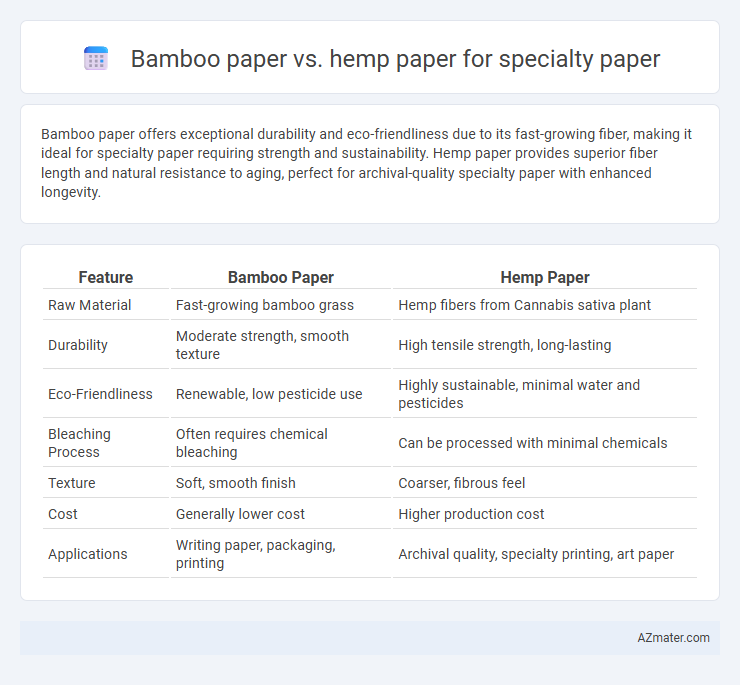Bamboo paper offers exceptional durability and eco-friendliness due to its fast-growing fiber, making it ideal for specialty paper requiring strength and sustainability. Hemp paper provides superior fiber length and natural resistance to aging, perfect for archival-quality specialty paper with enhanced longevity.
Table of Comparison
| Feature | Bamboo Paper | Hemp Paper |
|---|---|---|
| Raw Material | Fast-growing bamboo grass | Hemp fibers from Cannabis sativa plant |
| Durability | Moderate strength, smooth texture | High tensile strength, long-lasting |
| Eco-Friendliness | Renewable, low pesticide use | Highly sustainable, minimal water and pesticides |
| Bleaching Process | Often requires chemical bleaching | Can be processed with minimal chemicals |
| Texture | Soft, smooth finish | Coarser, fibrous feel |
| Cost | Generally lower cost | Higher production cost |
| Applications | Writing paper, packaging, printing | Archival quality, specialty printing, art paper |
Introduction to Specialty Paper
Specialty paper includes a variety of unique, high-performance papers designed for specific applications, with bamboo paper and hemp paper being prominent examples due to their sustainability and durability. Bamboo paper offers a smooth texture and high tensile strength, making it ideal for fine art, stationery, and packaging, while hemp paper is praised for its long fibers that enhance tear resistance and longevity, favored in archival documents and eco-friendly products. Both types contribute to reducing environmental impact by utilizing fast-growing and renewable resources, aligning with the growing demand for eco-conscious specialty paper alternatives.
Overview of Bamboo Paper
Bamboo paper is a sustainable specialty paper made from fast-growing bamboo fibers, offering excellent durability and smooth texture ideal for printing and artistic applications. Its eco-friendly production process uses less water and chemicals compared to traditional wood pulp paper, making it a preferred choice in green packaging and stationery markets. Bamboo paper's natural antibacterial properties and high tensile strength enhance its performance and extend the lifespan of documents and artworks.
Overview of Hemp Paper
Hemp paper offers superior durability, environmental sustainability, and higher cellulose content compared to traditional wood and bamboo paper, making it ideal for specialty paper applications requiring strength and longevity. Its faster growth cycle and minimal pesticide use result in reduced ecological impact, positioning hemp as a renewable resource in eco-friendly paper production. Specialty items like archival documents, art papers, and currency often utilize hemp paper due to its resistance to yellowing and high tensile strength.
Raw Material Sourcing and Sustainability
Bamboo paper is sourced from fast-growing bamboo plants, which can be harvested every 3-5 years, offering a highly renewable raw material with minimal need for pesticides or fertilizers. Hemp paper derives from industrial hemp, a crop known for its low environmental footprint, rapid growth cycle of around 3-4 months, and ability to regenerate soil health through phytoremediation. Both raw materials contribute to sustainability by reducing deforestation, but bamboo's higher yield per acre contrasts with hemp's soil benefits and lower water consumption, influencing specialty paper production choices.
Environmental Impact Comparison
Bamboo paper offers a faster growth cycle and higher yield per acre compared to hemp paper, resulting in more efficient land use and reduced deforestation pressure. Hemp paper, however, typically requires fewer pesticides and herbicides, contributing to lower chemical runoff and enhanced soil health. Both materials present sustainable alternatives to traditional wood paper, with bamboo excelling in renewable biomass and hemp offering superior biodegradability and nutrient-rich fiber residues.
Fiber Strength and Paper Durability
Bamboo paper exhibits exceptional fiber strength due to its dense vascular bundles, resulting in superior tear resistance and tensile strength ideal for specialty paper applications. Hemp paper fibers, longer and coarser, provide remarkable durability and resistance to aging, making it a preferred choice for archival-quality documents. Both fibers contribute to eco-friendly, sustainable paper products but differ in texture and longevity, with hemp generally outperforming bamboo in long-term preservation.
Print Quality and Texture Differences
Bamboo paper offers a smooth texture with a fine grain that enhances print clarity, making it ideal for high-resolution images and detailed graphics in specialty paper applications. Hemp paper features a coarser texture and natural fiber patterns, providing a unique tactile experience and slightly absorbent surface that can affect ink saturation and drying time. Both papers are eco-friendly, but bamboo excels in delivering crisp and vibrant prints, while hemp adds a rustic aesthetic favored for artisanal designs.
Cost Analysis: Bamboo vs Hemp Paper
Bamboo paper generally offers a more cost-effective option due to its faster growth rate and higher yield per acre compared to hemp, resulting in lower raw material expenses. Hemp paper, while typically more expensive because of labor-intensive processing and limited supply, provides superior durability and environmental benefits that may justify the higher upfront cost for specialty applications. Evaluating total production costs, including cultivation, processing, and finishing, reveals bamboo paper as a budget-friendly alternative with scalability advantages in specialty paper markets.
Applications in Specialty Markets
Bamboo paper offers exceptional strength and smoothness, making it ideal for luxury packaging, artisanal notebooks, and eco-friendly stationery in specialty markets. Hemp paper stands out for its durability and resistance to wear, frequently used in archival documents, currency, and specialty filters. Both papers cater to sustainability-focused industries but target distinct applications based on fiber properties and production benefits.
Future Prospects and Industry Trends
Bamboo paper is gaining traction in the specialty paper industry due to its rapid renewability, strength, and eco-friendly production process, aligning with increasing consumer demand for sustainable products. Hemp paper offers superior durability and biodegradability, making it ideal for premium, archival, and specialty packaging applications, with industry trends emphasizing hemp's low environmental impact and carbon sequestration benefits. Future prospects indicate a growing shift toward blending bamboo and hemp fibers to optimize cost-efficiency, durability, and ecological advantages in specialty paper manufacturing.

Infographic: Bamboo paper vs Hemp paper for Specialty paper
 azmater.com
azmater.com